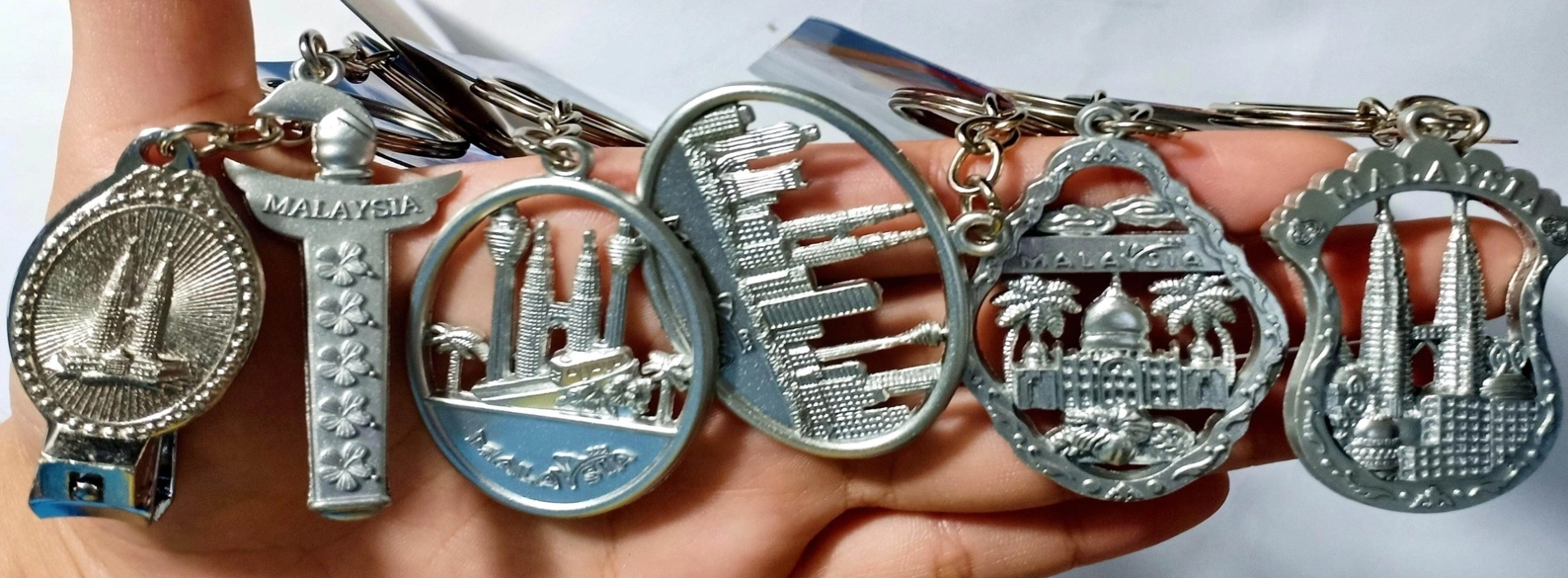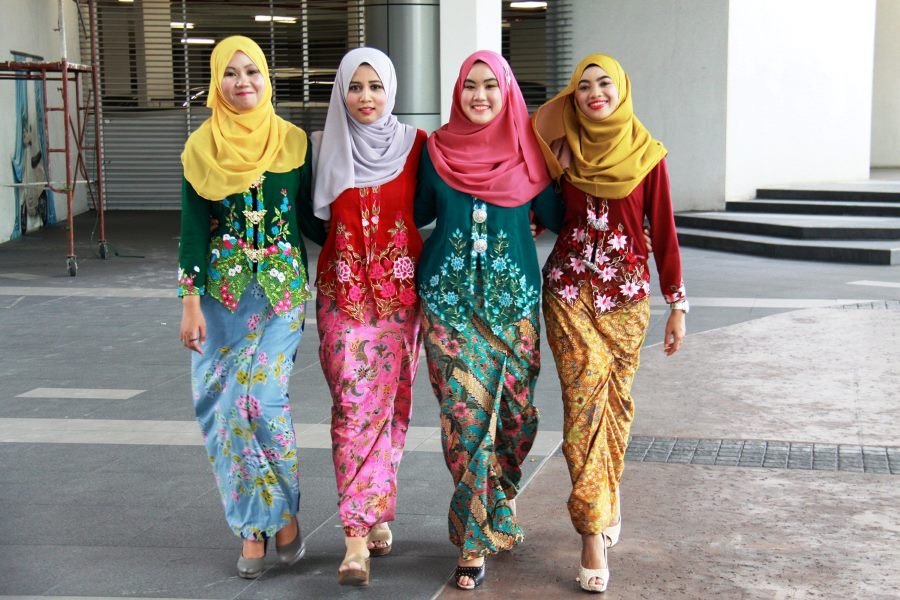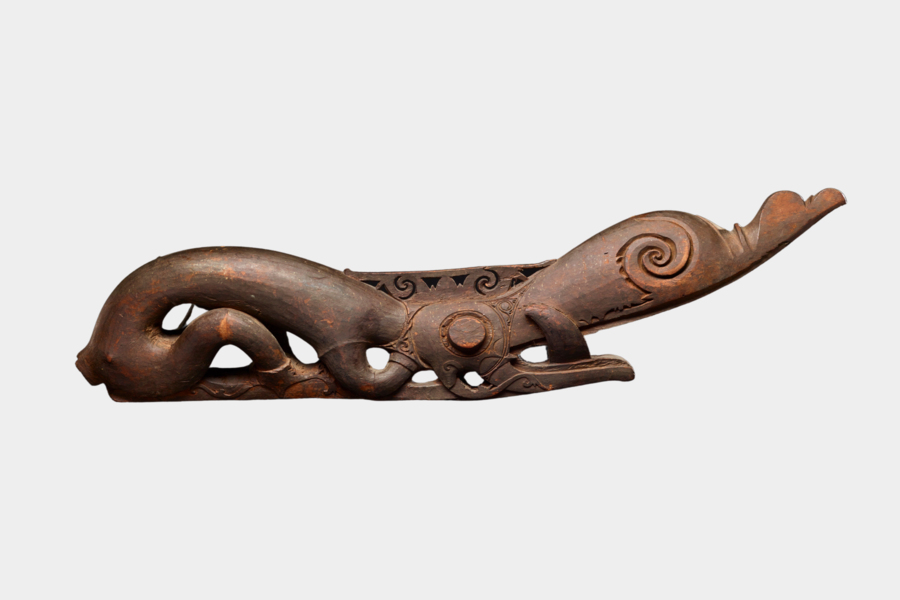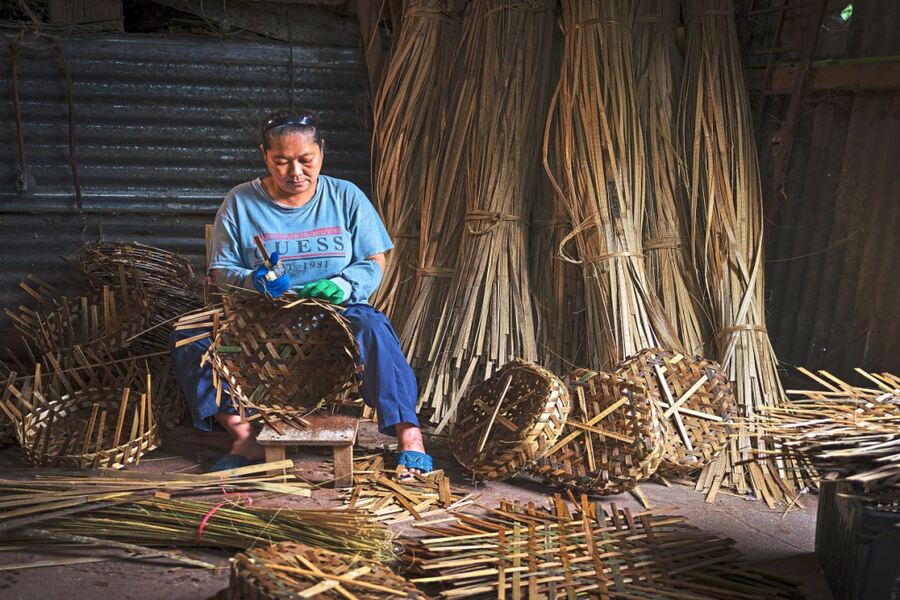
Souvenirs are always a good idea to preserve trip memories and provide a unique gift for loved ones. By looking at the characteristic souvenirs displayed, you can recall the whole culture of a country.

A Malaysia souvenir kiot in an airport - Photo: Malaysia Airports
Known as the shopping paradise of Southeast Asia, Malaysia has many large commercial centers with many luxury brands. But if you want to keep souvenirs typical of Malaysian culture, here are some interesting suggestions for you. Coming to Malaysia with Asia King Travel, let’s find out about these meaningful gifts!
Batik is a cherished art form in Malaysia, reflecting the richness of the country's cultural heritage. By specific method, the stunning patterns will be printed on some fabric material like soft cotton or silk by wax-resist dyeing technique. Those designs are inspired by natural beauty (plants, animals, and folklore).
.jpg)
The craft of making batik fabric is hundreds of years old - Photo: VnExpress
Batik has become more common as a work of art besides being used as everyday clothing or home decoration. Owning a Batik piece is more than just acquiring a beautiful item—it's a way to honor local artisans and help preserve Malaysia’s vibrant artistic traditions, one design at a time.
Although I’ve never personally bought a kebaya (for reasons that will soon become obvious), I can’t help but be captivated by its graceful beauty every time I see one.
For those who may not know, the kebaya is a long-sleeved traditional blouse for women that is designed to cinch at the waist to showcase the wearer's figure. It is generally made out of lace or cotton and elaborately adorned with bright patterns and intricate embroidery.

Modernized Version of Kebaya is more common these days - Photo: Omar Ali
Though the kebaya is a fashion staple of Malaysia's Malay and Peranakan communities, the kebaya transcends racial boundaries. In fact, it is even the official uniform of the country's national airline!
Another exciting thing is that it is rather easy to distinguish between the modernized type of Kebaya from its conventional style. For instance, while the conventional Kebaya often displays deep and jeweled colors, the modernized version usually makes use of trending features in lighter, pastel colors.
Traditional Malay woodcarving uses two big techniques: 'ukiran timbul' and 'ukiran tebuk'. The first involves carving floral and geometrical designs in relief, commonly applied to panels, walls, pillars, and doors in the traditional Malay palaces and homes, while the latter specializes in piercing or cutting out patterns to let the air through and are applied to such architectural elements as windows, fanlights, partitions, and railings.

Malay woodcarving is one of the oldest traditional crafts techniques- Photo: Antonio J. Guerreiro
Sometimes the more elaborate carving is even embellished with gold paint. This is evident from the old palaces where exemplary works are found adorning the roof ridges, eaves, fanlights, and friezes of such historic palaces as the Istana Kenangan in Kuala Kangsar, Perak.
Pewter, an alloy of tin combined with metals, has been an important craft in Malaysia for centuries. Because of the complexity of the designs and the ability for great attention to detail, Malaysian pewter smiths have been highly sought after and respected all over the world. From decorative items to functional tableware, everything is painstakingly crafted, many times using traditional themes and symbols. The art of pewter making says a lot about the rich metalwork heritage of the country and the skills of the craftsmen.
Songket is the traditional Malaysian process of weaving precious fabrics that are intricately patterned with gold or silver threads. Songket weaving is quite laborious, since it requires much expertise and patience.
.jpg)
Songket sold on National Craft Day, an annual festival held by the Malaysian Handicraft Development Corporation - Photo: Wan Manang Songket
Most of the patterns and motifs woven on these fabrics carry symbolic meanings, often related to nature, royalty, and several cultural beliefs. These valuable Songket textiles are highly treasured and used as traditional attire, accessories, and for many other decorative purposes.
This is one of the very old crafts in Malaysia, each region having its unique style and technique. The skillful weaving of rattan, bamboo, and mengkuang leaves by the artisans turns them into something beautiful and functional.

An artisan crafting a basket intended for storing fish at a factory in Teluk Intan, Perak. — Photos: MAHIZZAN FADZIL
These baskets serve practical purposes and reflect the creativity and resourcefulness of the local communities. Many basket designs incorporate symbolic motifs and patterns, representing cultural narratives and traditions.
Read more: Malaysia Tours 5 days
Malaysian rendang should be the first on this list as an iconic local delicacy. Rendang is a slow-cooked meat dish that is rich, flavorful, and incredibly tender. The main ingredients of this dish usually are beef or chicken, with many other spices. The texture of rendang is thick (almost like soft butter), and although its look is quite similar to curry, it has a different flavor.
.jpg)
Beef rendang is slow-cooked on the stove in an aromatic paste - Photo: Bea & Marco
About the flavor of Rendang, the spices blend harmoniously, giving rendang a touch of heat that comes through subtly when eaten. The sensation of smell and taste of rendang are simply divine. It's a perfect gift for those who appreciate bold and aromatic flavors.
In Malaysia, it’s called “Keropok” for crispy crackers made from fish or prawn, while “Rempeyek” is for crispy fritters made from anchovies and peanuts. Crisp, crunchy, salty, nutty, and aromatic are the keywords to describe this dish. With a special recipe that reflects the significant flavor of Southeast Asian cuisine, Keropok and Rempeyek are great gifts to share with friends and family.
.jpg)
The Sweet Delight of Malaysia: Dodol - Photo: motherhood
Dodol is also a highlight of Malaysian cuisine, satisfying any sweet tooth. Simply put, dodol is a sweet and chewy, toffee-like candy made from palm sugar and coconut milk. It is often found in places with a rich Peranakan heritage, so think of gift shops in Penang and Melaka as your go-to place to find these delectable treats!
.jpg)
It is a symbol of unity, diversity and an icon of the Sarawakian culture! - Photo: malvina chieng
The Sarawak layer cake, or “kek lapis Sarawak”, is a colorful and intricately layered cake popular in Malaysia, particularly in the state of Sarawak. It is known for its vibrant patterns, achieved by stacking thin layers of cake in different colors and flavors. It is often served during festive occasions and as a unique gift or souvenir.
Durian-flavored snacks are popular souvenirs in Malaysia, offering a taste of the country's famous, polarizing fruit. These snacks range from durian candies, chips, and biscuits to chocolates, capturing the rich, creamy flavor of the durian in more accessible forms for those curious or fond of its unique taste.
.jpg)
Nasi Lemak chips from the famous brand in Malaysia - Photo: Kantin Lab
Nasi lemak chips are a creative snack inspired by Malaysia's beloved dish. These chips capture the essence of the traditional meal by incorporating flavors like coconut, sambal (spicy chili paste), anchovies, and peanuts, making them a popular and unique souvenir for food lovers.
Malaysia is known for its rich coffee and tea culture, with popular options like “kopi” (local coffee) and “teh tarik” (pulled tea). Malaysian coffee often has a bold, roasted flavor, while tea blends, including those from the Cameron Highlands, offer aromatic and robust varieties. These beverages are commonly packaged as gifts or souvenirs, representing the country's diverse flavors.
These oils certainly make great souvenirs from Malaysia for those who believe in their therapeutic properties.
.jpg)
Nutmeg oil is a precious gift for sick people - Photo: CKC
The two most popular oils in Malaysia are “gamat” (sea cucumber) oil, which is said to be effective in healing wounds and alleviating toothaches. And nutmeg oil, which supposedly treats headaches, intestinal discomfort, joint pains, and more.
Gamat oil is most often found in Langkawi, while nutmeg oil is commonly found in Penang pharmacies and gift shops.
If you’d like to bring home some of that Malaysian culinary goodness, try getting some of its popular herbs and spices. Most of these are sold either in a pre-cooked paste or as spice packets.
.jpg)
Grows mainly in the north of the island of Borneo, in the state that also bears its name: Sarawak - Photo: Marhaba
For example, Sarawakian peppercorns are a good choice. Not only do they pack a punch, but they’re fragrant and extremely versatile as an ingredient. If you want to have more aromatic flavor in your meal, consider putting some cumin seeds, fennel seeds, star aniseeds, etc. These are famous herbs and spices that you can easily find anywhere in Malaysia with high quality. They're definitely one of the best things to buy in Malaysia!
Many of the Malaysian souvenirs mentioned are so popular that you can pretty much find them anywhere (including in many supermarkets like Lotus’s, AEON, and Jaya Grocer). Kebaya or fabric products can be found in most Malay clothing stores throughout the country.
.jpg)
As part of Old Kuala Lumpur, Pasar Seni is Central Market for the locals - Photo: Farihah
However, specific locations are more famous than others for buying unique things in Malaysia. You can consider the predominantly Malay-majority states of Kelantan and Terengganu for the best batik (check out batik TEKTURA, Batik Boutique in Kuala Lumpur, or Batek Lah in Penang).
For tasty food souvenirs, visit Him Heang in Penang and Happiness Confectionery in Ipoh for delicious Chinese pastries. In Melaka, the shops along Jonker Street offer treats like dodol and other traditional confections. If you're after something unique, check out Kantin Lab for their irresistible nasi lemak chips.
Traditional markets such as Pasar Seni in Kuala Lumpur are your best bet for charming trinkets like wooden or rattan crafts. At the same time, clothing stores like Pestle Mortar Clothing offer trendy local apparel.
Malaysia’s rich cultural diversity is beautifully reflected in the wide variety of gifts and souvenirs available, and shopping for these items offers a unique opportunity to support local artisans and preserve traditional crafts.
Read more: Malaysia Tours 10 days